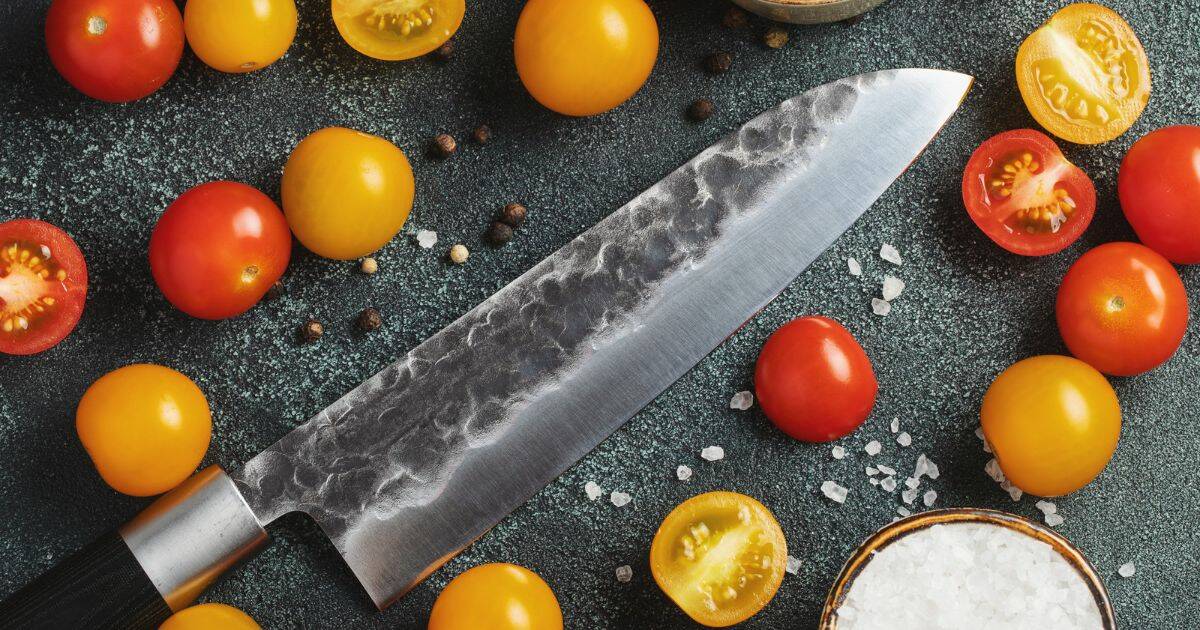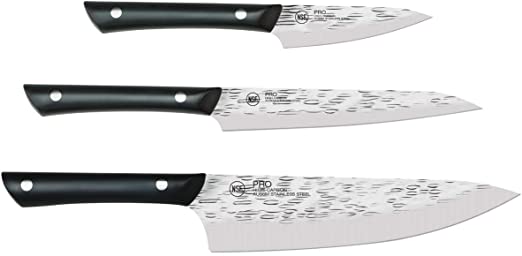Picture this: you’re slicing through a ripe, juicy tomato when suddenly, the knife slips and you’re left with a mangled mess that barely resembles the fruit it once was. We’ve all been there, but fear not, fellow food fanatics! There’s a hero in our midst, and its name is the petty knife.
In this article, we’ll take a deep dive into the world of petty knives, answering all your burning questions and maybe even saving your future tomatoes from a squishy demise.
So, sharpen your culinary curiosity and prepare for a crash course in all things petty knife, as we tackle these pressing questions:
What is a petty knife?
Why is it called a petty knife?
What is the ideal petty knife size?
What types of food can you cut with a petty knife?
What are the various uses for a petty knife?
Petty knife vs. paring knife: what are the differences?
Do I need a petty knife and a paring knife in my kitchen arsenal?
Grab a snack, and let’s embark on this cutting-edge journey together!
What Is A Petty Knife?
A petty knife, also known as a utility knife, is a versatile and essential tool in the culinary world. Smaller than a chef’s knife but larger than a paring knife, it strikes the perfect balance for tackling a wide variety of tasks in the kitchen.
Common Features Of A Petty Knife Include:
Blade length: Typically ranging from 4 to 6 inches, this allows for precision and control during intricate tasks.
Blade shape: Petty knives usually have a narrow, pointed blade, which makes them ideal for detailed work, such as peeling, trimming, and slicing.
Sharpness: These knives are designed to be incredibly sharp, ensuring clean cuts and minimal damage to the food you’re working with.
In essence, a petty knife is like the Swiss Army knife of the kitchen, allowing you to skillfully maneuver through a multitude of cooking tasks with ease and precision. Whether you’re a professional chef or a home cooking enthusiast, a petty knife is a must-have addition to your cutlery collection.
The Origin Of The Name “petty Knife”
You might be wondering, why is this incredibly useful kitchen tool called a “petty” knife? Does it have something to do with being small and inconsequential? Fear not, for the origin of the name has nothing to do with pettiness at all!
The term “petty knife” actually stems from the French word “petit,” which means “small” or “little.” This name is quite fitting, given that the petty knife is smaller in size compared to the larger chef’s knife, yet still larger than the paring knife.
Historically, the petty knife has been an essential part of European cutlery, known for its versatility and precise cutting abilities. The name has since been adopted and popularized in English-speaking countries, where it continues to be a staple in kitchens around the world.
So, rest assured, the petty knife isn’t here to cause drama or stir up trouble; it’s simply a small but mighty culinary companion, ready to assist you with a wide range of kitchen tasks.
Ideal Petty Knife Size
When it comes to choosing the perfect petty knife for your kitchen, size does matter. As mentioned earlier, petty knives typically range from 4 to 6 inches in blade length. However, the ideal size for you depends on a few factors, such as your hand size, the tasks you plan to use it for, and your personal preference.
Here are some tips for selecting the right petty knife size:
Hand size: If you have smaller hands, a 4-inch petty knife might be more comfortable and easier to maneuver. Conversely, those with larger hands might prefer a 5 or 6-inch blade for better control.
Kitchen tasks: Consider the types of tasks you’ll be using the petty knife for. If you plan on doing mostly detailed work, such as peeling or trimming, a smaller blade might be more suitable. If you need a versatile knife for a variety of tasks, including slicing and chopping, a larger blade could be a better choice.
Personal preference: Ultimately, the best petty knife size for you comes down to personal preference. It’s essential to feel comfortable and confident while using the knife, so choose a size that feels right in your hand and meets your specific needs.
The Art Of Cutting With A Petty Knife
Now that you’ve got a better understanding of what a petty knife is and how to choose the right size, it’s time to explore the types of food you can cut with this versatile tool. The petty knife is perfect for a wide variety of ingredients, even slicing vegetables, making it a true kitchen workhorse.

Here are some examples of what you can cut with a petty knife:
Fruits: From slicing apples to segmenting citrus fruits, the petty knife excels at precise fruit cutting tasks.
Vegetables: The petty knife is perfect for trimming and peeling vegetables, such as carrots and potatoes, as well as slicing smaller veggies like shallots and garlic.
Herbs: Finely chopping herbs, such as parsley and cilantro, is a breeze with a petty knife, thanks to its sharp and nimble blade.
Meat and fish: The petty knife’s precision makes it great for tasks like deboning chicken, filleting fish, or trimming fat from meat.
With the right technique, your petty knife will make quick work of these tasks, leaving you with beautifully prepared ingredients ready for cooking. Remember to keep your knife sharp and practice proper cutting techniques to ensure your safety and the best results.
Petty Knives: A Multitude Of Uses
As we’ve already established, the petty knife is an incredibly versatile tool in the kitchen. From fruits and vegetables to meats and fish, it can handle a wide range of tasks with ease. Let’s dive a little deeper into some common uses for the petty knife, so you can make the most of this culinary gem.
Some popular uses for a petty knife include:
Peeling: The sharp, narrow blade of the petty knife makes it perfect for peeling fruits and vegetables with precision.
Slicing: From thinly slicing delicate ingredients like tomatoes to portioning cheese, the petty knife’s sharp edge ensures clean and precise cuts.
Trimming: Use your petty knife to trim excess fat from meats, remove stems from strawberries, or clean up artichokes.
Mincing: The petty knife’s nimble nature makes it an excellent choice for finely mincing ingredients like garlic and shallots.
Deboning: Though not as specialized as a boning knife, a petty knife can be used to debone poultry or small cuts of meat when needed.
The Best Use For A Petty Knife
With so many potential uses for a petty knife, you might be wondering what its absolute best use is. While it’s difficult to pin down a single “best” use for this versatile tool, many professional chefs and home cooks agree that the petty knife truly shines when it comes to precision tasks.

Whether it’s peeling a delicate fruit, trimming excess fat from a cut of meat, or finely mincing herbs, the petty knife’s sharp and agile blade allows for exceptional control and accuracy. When you need to execute detailed work in the kitchen, the petty knife is often the ideal choice.
Of course, this doesn’t mean that the petty knife is limited to these tasks. As we’ve seen, it’s a versatile and adaptable tool that can handle a wide range of kitchen duties. The key is to find the tasks where your petty knife performs best for you and make it your go-to tool for those jobs.
Petty Knife Vs. Paring Knife: What Are The Differences?
When it comes to small, versatile kitchen knives, both the petty knife and paring knife reign supreme. However, these two knives have their own unique characteristics and uses. Let’s compare and contrast the petty knife and paring knife to help you understand the differences between them.
Size and shape: While both knives are on the smaller side, the petty knife generally has a slightly longer and narrower blade compared to the paring knife. Paring knives typically have a blade length of 3 to 4 inches, while petty knives range from 4 to 6 inches.
Uses: Both knives are suitable for a variety of tasks, but the petty knife’s longer blade makes it better suited for tasks requiring more precision and control, such as slicing fruits, vegetables, and cheeses. The paring knife, on the other hand, is excellent for tasks like peeling, trimming, and coring, thanks to its shorter blade.
Grip: The paring knife’s shorter blade allows for a different grip compared to the petty knife. Users often hold the paring knife with a pinch grip, with the thumb and index finger gripping the blade itself for increased control during intricate tasks.
Do I Need A Petty Knife And A Paring Knife?
With their overlapping uses and similarities, you may be wondering if you need both a petty knife and a paring knife in your kitchen. The answer depends on your cooking habits and personal preferences.

Advantages of having both:
Versatility: Owning both a petty knife and a paring knife increases the range of tasks you can comfortably tackle in the kitchen, making your culinary adventures more enjoyable and efficient.
Precision: While there is some overlap in their uses, each knife excels in specific tasks. Having both allows you to choose the best tool for the job, resulting in cleaner, more precise cuts.
Assessing your kitchen needs:
If you frequently engage in a variety of cooking tasks that require precision, such as peeling, trimming, slicing, and mincing, having both knives could be beneficial.
If you’re on a budget or have limited space, you might choose the knife that best suits the majority of your kitchen tasks. In this case, the petty knife’s versatility might make it the better choice for most home cooks.
Ultimately, the decision comes down to your specific needs and preferences. If you have the opportunity, try using both knives in your kitchen to determine which one works best for you.
Top Petty Knife Picks
With a myriad of petty knives on the market, it can be overwhelming to choose the right one for your needs. To help you make an informed decision, we’ve compiled a list of some of the best petty knives available, along with key features to look for when shopping for your perfect petty companion.
Looking for something different? Try these out as I’ve owned knives from all of these companies over my career.
Key features to look for:
Blade material: High-carbon stainless steel is the most common choice for its durability, sharpness, and resistance to corrosion.
Handle: Comfort and grip are crucial when selecting a petty knife. Look for ergonomic designs and materials that feel secure in your hand.
Balance: A well-balanced knife ensures better control and precision during use. Hold the knife to see if it feels comfortable and balanced in your hand.
Edge retention: Choose a knife with excellent edge retention to maintain its sharpness and reduce the frequency of sharpening.
The World Of Japanese Petty Knives
Japanese petty knives have gained popularity among professional chefs and home cooks alike, thanks to their impeccable craftsmanship, sharpness, and unique design. Let’s explore the characteristics that set Japanese petty knives apart and why they’re so beloved in the culinary world.

Unique characteristics of Japanese petty knives:
Sharpness: Japanese knives are renowned for their incredibly sharp edges, which allow for precision cuts and minimize damage to the food being prepared.
Blade material: Japanese knives often use high-quality steel, such as VG-10 or SG-2, which contributes to their sharpness, edge retention, and durability.
Aesthetic: Japanese petty knives often feature beautiful designs, such as Damascus patterns or hammered finishes, making them not only functional but also visually stunning.
Reasons for their popularity:
Performance: The sharpness and precision of Japanese petty knives make them a favorite among chefs and home cooks who value accuracy and control in their cooking.
Craftsmanship: Japanese knives are often handcrafted using centuries-old techniques, resulting in knives of exceptional quality and durability.
Unique design: The combination of form and function makes Japanese petty knives a popular choice for those who appreciate both aesthetics and performance in their kitchen tools.
Whether you’re a seasoned chef or a home cook looking to elevate your culinary skills, a Japanese petty knife could be the perfect addition to your kitchen arsenal.
Key Takeaways
Before we wrap up, let’s take a moment to recap the essential points we’ve covered about petty knives. Here are the key takeaways from this article:
Petty knives are versatile kitchen tools, ideal for precision tasks such as slicing, peeling, trimming, and mincing.
A petty knife typically has a blade length between 4 to 6 inches, with the ideal size depending on your hand size and intended use.
The main differences between a petty knife and a paring knife lie in their size, shape, and specific uses, with some overlap in functionality.
Japanese petty knives are highly regarded for their sharpness, craftsmanship, and unique designs.
Having both a petty knife and a paring knife in your kitchen can increase versatility and efficiency, but choosing between them depends on your cooking habits and personal preferences.
Embracing The Versatility Of The Petty Knife
As we’ve explored the world of petty knives, it’s evident that these small yet mighty tools have earned their place in the culinary world. Whether you’re a professional chef or a home cook, a well-chosen petty knife can make all the difference in your kitchen, providing precision, control, and versatility.
With an understanding of the key features to look for and a grasp on the differences between petty knives and paring knives, you’re now equipped to find the perfect knife to enhance your cooking experience. So, embrace the power of the petty knife and take your culinary skills to new heights!
Frequently Asked Questions
How Do I Properly Care For My Petty Knife?
To ensure your petty knife stays in top condition, clean it by hand with warm soapy water and dry it immediately after use. Avoid using abrasive cleaners or placing it in the dishwasher, as these can damage the blade and handle. Store your knife in a knife block, on a magnetic strip, or in a protective sheath to prevent the edge from becoming dull. Regularly sharpen your knife with a sharpening stone or honing rod to maintain its sharpness and performance.
What’s The Difference Between A Petty Knife And A Utility Knife?
While petty knives and utility knives share some similarities, the primary difference lies in their blade length and shape. Petty knives usually have a blade length between 4 to 6 inches and are well-suited for precision tasks like slicing, peeling, and trimming. Utility knives have slightly longer blades, usually with blade lengths between 6 to 8 inches, and are more versatile for general-purpose cutting tasks, such as slicing sandwiches, larger fruits, and vegetables.
How Often Should I Sharpen My Petty Knife?
The frequency of sharpening your petty knife depends on how often you use it and the type of steel used in its construction. As a general rule, sharpen your knife when you notice a decline in its cutting performance or if it feels dull. For home cooks, this might be every few months, while professional chefs might need to sharpen their knives more frequently. Using a honing rod between sharpenings can help maintain the edge and prolong the time between full sharpenings.




